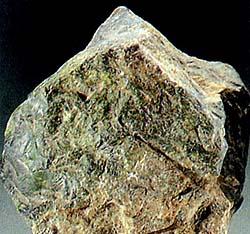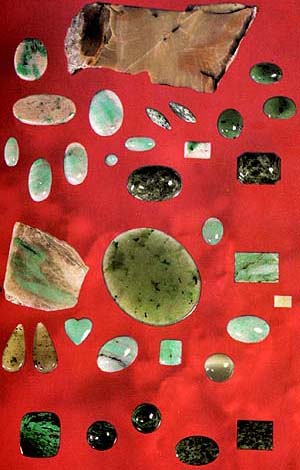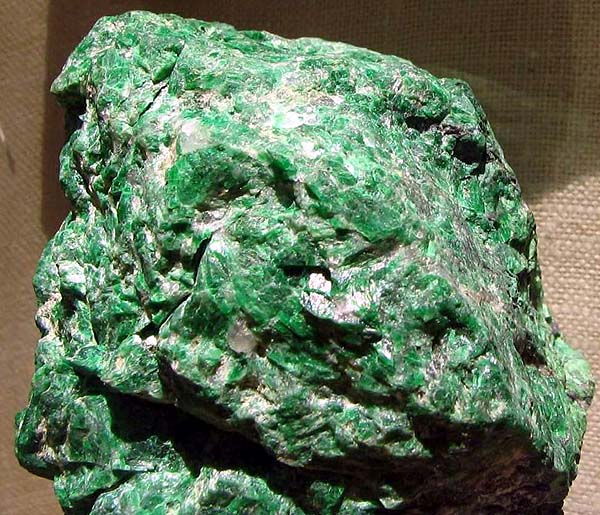Stone, minerals and semiprecious of the world stone
Pyroxene (silicates): Jadeite -->rus
 Diagnostic cart.
Diagnostic cart.
Na Al Si2O6
Crystal structure monoclinic
Hardness on the Mohs scale 6,5-7
Specific unit weight mass 3,2-3,3
Cleavage perfect absolute
Fracture, break shows up hardness
Colors colourless, polycoloured (multicoloured)
Colors in powder triturate white
Glance (glitter, glare) from glass to mother-of-pearl

 The name "jade" ascends to time of subjugation of Central and Sonth America reigning at the off-shore seasides and waters Spanishes and means literally "lumbar stone" (piedra de ijada) - jade was considered a talisman, curing illnesses of buds. Through Europe this name spread all over the world. The proper Chinese name "iyu" did not get distribution.
The name "jade" ascends to time of subjugation of Central and Sonth America reigning at the off-shore seasides and waters Spanishes and means literally "lumbar stone" (piedra de ijada) - jade was considered a talisman, curing illnesses of buds. Through Europe this name spread all over the world. The proper Chinese name "iyu" did not get distribution.
In 1863 the French researcher A. Demur rotined that under the name "jade", related to the extraordinarily viscid stone, to known already 7 millenniums, it is actually necessary to understand two minerals: jadeite and nephrite. In trade of jade many opaque green stone name wrong.
To distinguish a nephrite and jadeite on an eye in general not easily, that grounds to use the collective term of "jade" for both minerals. In prehistoric time of jade due to unusual viscidity and durability used in all of parts of the world for making of weapon, instrument and tools. Out of nephrite and jadeite axes and axes made, in particular.
More than 2000 years back in China of jade widely used for making of attributes of cult - sacred statuettes and other sacral objects, and also insignia and other characters of state power. In pre-columbian America jade was valued dearer than gold. However as a result of encroachment of Spanish conquistador the high art of screw-thread on this stone was quickly lost.
In China this branch of the applied art is not stopped until now. Before a nephrite was there processed only, but already one and a half centuries a screw-thread is here mastered on jadeite, to brought from Burma.
In trade the name of this adamant can belong both to to actually to jadeite and to the nephrite (green difference of actinolite, mineral from the group of amphiboles). Jadeite does not form separate crystals. More frequent than all it is presented as microcrystalline aggregates, transparent or translucent, with the separate black rounded including. Can have the various colouring (white, rose, orange, brown, black). Those differences of jadeite, which possess the very saturated emerald-green colouring, related to the presence of chrome, are most valued, and also violet, which gives out the presence of manganese.
Jadeite got the name from jade. Due to the confusingly-fibred structure of войлоко-like aggregates extraordinarily viscid and designated. For jeweller-carpentry jadeite the мелко- and short-grained sheaf (paniculate) or toothed granoblastic structure is characteristic. A confusingly-fibred (downy) microstructure is typical for a nephrite. The grainy structure of jadeite is visible with a naked eye or looked over at a 10-20-multiple increase, due to what it can be distinguished from a nephrite.
Jadeite is the most different flowers. In a fresh fracture brilliance of jadeite is dim, and on the polished surface - fat, sometimes with a mother-of-pearl ebb. "Imperial-jade" ("emperor's jade") is most valued is a semilucent variety from Burma, painted the admixture of chrome in a emerald-green color.
Khloromelanit - dark-green with black spots variety of jadeite.
"Jade-albite" (albite jadeitite) - intense-green with black spots aggregate of albite and jadeite from Overhead Burma.
Diagnostic indication.
In flame of candle melt fuse easily, transformed in vitreous glassy semilucent mass. In muriatic acid does not dissolve. Entangling minerals, taken to jade, is possible with agalmatolite, by an amazon-stone, green aventurine, bowenite, Californite, chrysoprase, oficalcite ("by a Connemarsky marble"), grossulyare, plasma, praseme, Prehnite, serpentine, smithsonite, zinc spar, Williamsite. It is possible to entangle with basaltic parting cleavage (basalt), often concealed from above a green pomegranate olivine (Chrysolite). A basalt in itself is brownish-rather yellow-grey (Ignache-Cross, North of Russian, CIS).
Origin provenance genesis.
Be found as dense the masses into the layers of metamorphic rocks (crystalline slates).
Deposit minefield mine and use.
From the historical and commercial point of view a most value is had bed of jadeite in north Burma. Jadeite, highly honoured the people of the East, used as very valuable carpentry stone. The most considerable deposits of jadeite, located in Overhead Burma, near Taumau, are presented extensive declivous areas in serpentinite; it is obtained also from the second deposits - conglomerates, river pebble and boulders. There are also deposits in China (Sin'Czyan, Tibet, Yun'Nan'), Guatemala, Japan, Mexico, USA (state of Californium), CIS (Kazakhstan). On a photo - jadeite and nephrite.
Nephritis (jade) - an amphibole, variety of actinolite, (по-Greek. nephros is a bud) is yet more viscid, than jadeite. Colourings of him are various, green nephrites are most valued. Spots and bars are not uncommon. Nephritis (jade) be found in nature more frequent than jadeite, traditional deposits: Sin'czyan, near Kashgara and Khotana (China) are areas in serpentine, green marble, river pebble and boulders. The deposits of apple-spinach -green nephrite are known in East Sayane (CIS) - "Russian jade". Enough large deposits are present on the Sonth island of New Zeland, however from recent time the export of untilled nephrite from there is forbidden. Deposits are known in Australia (on peninsulaе Eyr), Burma, Brazil, Canada, Mexico, New Guinea, Taiwan, Poland (Iordanuva).
A nephrite and jadeite is used approximately identically: for making of jeweller and office decorations and articles of cult. Before jade polished only quartz sand, now it is processed a carborundum and diamond powder. The known centers of artistic treatment of nephrite and jadeite are located in Kantone, Beijing and Hong Kong.

Jadeite. Itmurundy, Kazakhstan, CIS. A photo: © A.A. Evseev.
